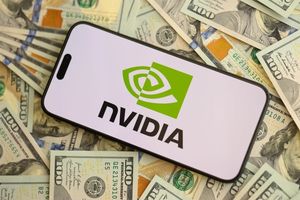
The semiconductor industry is currently a hotbed of activity, experiencing an unprecedented surge in investment and market valuation, primarily fueled by the insatiable demand for Artificial Intelligence (AI) and high-performance computing. As of November 2025, the sector is not only projected for significant growth, aiming for approximately $697 billion in sales this year—an 11% year-over-year increase—but is also on a trajectory to reach a staggering $1 trillion by 2030. This robust outlook has translated into remarkable stock performance, with the market capitalization of the top 10 global chip companies nearly doubling to $6.5 trillion by December 2024. However, this bullish sentiment is tempered by recent market volatility and the persistent influence of geopolitical factors.
The current landscape is characterized by a dynamic interplay of technological advancements, strategic investments, and evolving global trade policies, making the semiconductor sector a critical barometer for the broader tech industry. The relentless pursuit of AI capabilities across various industries ensures that chips remain at the core of innovation, driving both economic growth and technological competition on a global scale.
Unpacking the Market Dynamics: AI, Automotive, and Beyond
The primary engine propelling the semiconductor market forward in 2025 is undoubtedly Artificial Intelligence and the burgeoning demands of cloud computing. The hunger for AI accelerators, particularly Graphics Processing Units (GPUs) and High-Bandwidth Memory (HBM), is insatiable. Projections indicate that HBM revenue alone is set to surge by up to 70% in 2025, reaching an impressive $21 billion, underscoring the critical role of specialized memory in AI workloads. Hyperscale data centers continue to be major consumers, driving substantial demand for advanced processors and sophisticated memory solutions.
Beyond the dominant influence of AI, several other sectors are contributing significantly to the semiconductor boom. The automotive semiconductor market is on track to exceed $85 billion in 2025, marking a 12% growth. This expansion is attributed to the increasing semiconductor content per vehicle, the rapid adoption of electric vehicles (EVs), and the integration of advanced safety features. While some segments faced temporary inventory oversupply earlier in 2025, a robust recovery is anticipated in the latter half of the year, particularly for power devices, microcontrollers, and analog ICs, all critical components in the ongoing EV revolution. Furthermore, the Internet of Things (IoT) and the continued expansion of 5G networks are fueling demand for specialized chips, with a significant boom expected by mid-year as 5G and AI functionalities reach critical mass. Even consumer electronics, while considered mature, are projected to grow at an 8% to 9% CAGR, driven by augmented reality (AR) and extended reality (XR) applications, along with an anticipated PC refresh cycle as Microsoft ends Windows 10 support in October 2025.
Investment patterns reflect this optimistic outlook, with 63% of executives expecting to increase capital spending in 2025. Semiconductor companies are poised to allocate approximately $185 billion to capital expenditures this year, aimed at expanding manufacturing capacity by 7% to meet escalating demand. A notable trend is the significant increase in Research and Development (R&D) spending, with 72% of respondents forecasting an increase, signaling a strong commitment to innovation and maintaining technological leadership. Analyst sentiments are generally positive for 2025, forecasting continued financial improvement and new opportunities. However, early November 2025 saw a "risk-off" sentiment emerge, leading to a widespread sell-off in AI-related semiconductor stocks due to concerns about stretched valuations and the impact of U.S. export restrictions to China, temporarily erasing billions in market value globally. Despite this, the long-term growth trajectory driven by AI continues to inspire optimism among many analysts.
Corporate Beneficiaries and Competitive Realities
The AI-driven surge has created clear winners and intensified competition among key players in the semiconductor arena. NVIDIA (NASDAQ: NVDA) remains an undisputed leader in GPUs and AI chips, experiencing sustained high demand from data centers and AI technology providers. The company briefly surpassed a $5 trillion market capitalization in early November 2025, becoming the first publicly traded company to reach this milestone, though it later corrected to around $4.47 trillion amidst market adjustments. NVIDIA is also strategically expanding its custom chip business, collaborating with tech giants like Amazon (NASDAQ: AMZN), Meta (NASDAQ: META), Microsoft (NASDAQ: MSFT), Google (NASDAQ: GOOGL), and OpenAI to develop specialized AI silicon.
Other companies have also shown remarkable stock performance. Micron Technology Inc. (NASDAQ: MU) saw its stock soar by 126.47% over the past year. Advanced Micro Devices (NASDAQ: AMD) was up 47% year-to-date as of July 29, 2025, despite experiencing a recent tumble in early November. Broadcom (NASDAQ: AVGO) also saw declines in early November but reported a staggering 220% year-over-year increase in AI revenue in fiscal 2024. Other strong performers include ACM Research (NASDAQ: ACMR), KLA Corp (NASDAQ: KLAC), and Lam Research (NASDAQ: LRCX).
The competitive landscape is further shaped by the strategic moves of integrated device manufacturers (IDMs), fabless design firms, foundries, and equipment manufacturers. TSMC (NYSE: TSM) (Taiwan Semiconductor Manufacturing Company) maintains its dominant position as the world's largest contract chip manufacturer, holding over 50% of the global foundry market. Its leadership in advanced process nodes (3nm and 2nm) is crucial for producing chips for major AI players. Intel (NASDAQ: INTC) continues to innovate in high-performance computing and AI solutions, focusing on its 18A process development and expanding its foundry services. Samsung Electronics (KRX: 005930) excels in memory chips (DRAM and NAND) and high-end logic, with its foundry division also catering to the AI and HPC sectors. ASML Holding (NASDAQ: ASML) remains indispensable as the dominant supplier of extreme ultraviolet (EUV) lithography machines, critical for manufacturing the most advanced chips. Furthermore, tech giants like Amazon Web Services (AWS), Google, and Microsoft are increasingly developing their own custom AI and cloud processors (e.g., Google's Axion, Microsoft's Azure Maia 100 and Cobalt 100) to optimize their cloud infrastructure and reduce reliance on external suppliers, indicating a significant shift in the competitive dynamics.
Broader Significance and Geopolitical Undercurrents
The current trends in the semiconductor sector are deeply intertwined with the broader AI landscape and global technological competition. The relentless pursuit of more powerful and efficient AI models necessitates continuous innovation in chip design and manufacturing, pushing the boundaries of what's possible in computing. This development has profound impacts across industries, from autonomous vehicles and advanced robotics to personalized medicine and smart infrastructure. The increased investment and rapid advancements in AI chips are accelerating the deployment of AI solutions, transforming business operations, and creating entirely new markets.
However, this rapid growth is not without its concerns. Geopolitical factors, particularly the ongoing U.S.-China technology rivalry, cast a long shadow over the industry. The U.S. government has implemented and continues to adjust export controls on advanced semiconductor technologies, especially AI chips, to restrict market access for certain countries. New tariffs, potentially reaching 10%, are raising manufacturing costs, making fab operation in the U.S. up to 50% more expensive than in Asia. While there are considerations to roll back some stringent AI chip export restrictions, the uncertainty remains a significant challenge for global supply chains and market access.
The CHIPS and Science Act, passed in August 2022, is a critical policy response, allocating $280 billion to boost domestic semiconductor manufacturing and innovation in the U.S. The 2025 revisions to the CHIPS Act are broadening their focus beyond manufacturers to include distributors, aiming to strengthen the entire semiconductor ecosystem. This act has already spurred over 100 projects and attracted more than $540 billion in private investments, highlighting a concerted effort to enhance supply chain resilience and reduce dependency on foreign suppliers. The cyclical nature of the industry, combined with AI-driven growth, could lead to supply chain imbalances in 2025, with potential over-supply in traditional memory markets and under-supply in traditional segments as resources are increasingly channeled toward AI-specific production.
Charting the Future: Innovation and Integration
Looking ahead, the semiconductor sector is poised for continued innovation and deeper integration into every facet of technology. Near-term developments are expected to focus on further advancements in AI chip architectures, including specialized neural processing units (NPUs) and custom ASICs designed for specific AI workloads, pushing the boundaries of energy efficiency and processing power. The integration of AI capabilities at the edge, moving processing closer to data sources, will drive demand for low-power, high-performance chips in devices ranging from smartphones to industrial sensors. The ongoing development of advanced packaging technologies will also be crucial for enhancing chip performance and density.
In the long term, experts predict a significant shift towards more heterogeneous computing, where different types of processors and memory are tightly integrated to optimize performance for diverse applications. Quantum computing, while still in its nascent stages, represents a potential future frontier that could dramatically alter the demand for specialized semiconductor components. Potential applications on the horizon include fully autonomous systems, hyper-personalized AI experiences, and advanced medical diagnostics powered by on-device AI. However, challenges remain, including the escalating costs of advanced manufacturing, the need for a skilled workforce, and navigating complex geopolitical landscapes. Experts predict that the focus on sustainable manufacturing practices and the development of next-generation materials will also become increasingly critical in the years to come.
A Sector Transformed: The AI Imperative
In summary, the semiconductor sector in November 2025 stands as a testament to the transformative power of Artificial Intelligence. Driven by unprecedented demand for AI chips and high-performance computing, investment patterns are robust, stock performances have been explosive, and analysts remain largely optimistic about long-term growth. Key takeaways include the pivotal role of AI and cloud computing as market drivers, the significant capital expenditures aimed at expanding manufacturing capacity, and the strategic importance of government initiatives like the CHIPS Act in shaping the industry's future.
This development marks a significant milestone in AI history, underscoring that the advancement of AI is inextricably linked to the evolution of semiconductor technology. The race for technological supremacy in AI is, at its heart, a race for chip innovation and manufacturing prowess. While recent market volatility and geopolitical tensions present challenges, the underlying demand for AI capabilities ensures that the semiconductor industry will remain a critical and dynamic force. In the coming weeks and months, observers should closely watch for further announcements regarding new AI chip architectures, updates on global trade policies, and the continued strategic investments by tech giants and semiconductor leaders. The future of AI, and indeed much of the digital world, will be forged in silicon.
This content is intended for informational purposes only and represents analysis of current AI developments.
TokenRing AI delivers enterprise-grade solutions for multi-agent AI workflow orchestration, AI-powered development tools, and seamless remote collaboration platforms.
For more information, visit https://www.tokenring.ai/.







